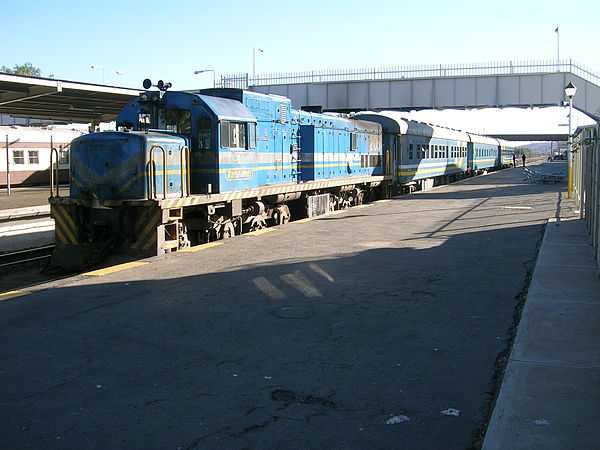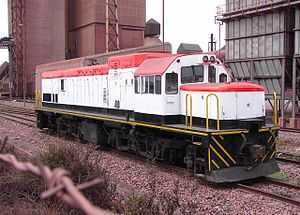South African Class 32-200
| South African Class 32-200 | |
|---|---|
|
PPC Saldanha’s Class 32-200 no. 32-202, 8 January 2009 | |
| Type and origin | |
| Power type | Diesel-electric |
| Designer | General Electric |
| Builder | General Electric |
| Serial number | 35842-35851 [1] |
| Model | GE U20C1 |
| Build date | 1966 |
| Total produced | 10 |
| Specifications | |
| UIC classification | 1Co+Co1 interlinked bogies |
| Gauge | 3 ft 6 in (1,067 mm) Cape gauge |
| Leading wheel diameter | 762 mm (30.0 in) |
| Wheel diameter | 915 mm (36.0 in) |
| Wheelbase |
4.927 m (16 ft 2.0 in) per bogie 8.128 m (26 ft 8.0 in) between pivots 13.246 m (43 ft 5.5 in) overall |
| Length | 16.866 m (55 ft 4.0 in) |
| Width | 2.756 m (9 ft 0.5 in) |
| Height | 3.924 m (12 ft 10.5 in) |
| Axle load |
Pony 10.180 t (10.019 long tons; 11.222 short tons) Traction 12.700 t (12.499 long tons; 13.999 short tons) |
| Locomotive weight |
93.000 t (91.531 long tons; 102.515 short tons) average 96.520 t (94.996 long tons; 106.395 short tons) maximum |
| Fuel type | Fuel oil |
| Fuel capacity | 4,300 L (950 imp gal; 1,100 US gal) |
| Prime mover | GE 7FDL-12 V12 |
| Engine RPM range |
400 rpm idle 1,000 rpm maximum |
| Engine type | 4 stroke diesel engine |
| Aspiration | Cooper Bessemer ET13 turbocharger |
| Generator | DC 10 pole GE 5GT-581C9 |
| Traction motors |
Six GE 5GE-761A9 DC 4 pole * 625A rating 1 hour * 615A rating continuous at 18 km/h (11 mph) |
| Cylinders | V12 |
| Transmission | diesel electric |
| Multiple working | 4 maximum |
| Performance figures | |
| Maximum speed | 100 km/h (62 mph) |
| Power output |
1,605 kW (2,152 hp) starting 1,490 kW (2,000 hp) continuous |
| Tractive effort |
183 kN (41,000 lbf) starting 146 kN (33,000 lbf) continuous at 27 km/h (17 mph) |
| Factor of adhesion |
25% starting, 20% continuous |
| Locomotive brake |
Air brake 28-LV-1 with vigilance control Not equipped with dynamic brakes |
| Locomotive brakeforce | 65% ratio at 345 kPa (50.0 psi) brake cylinder pressure |
| Train brakes |
700 L (150 imp gal; 180 US gal) main reservoir Compressor capacity at idle: 0.029 m3/s (1.0 cu ft/s) Exhauster capacity at idle: 0.116 m3/s (4.1 cu ft/s) |
| Career | |
| Operator(s) |
South African Railways Spoornet TransNamib Sudan Railway Goldfields PPC Lime Sheltam |
| Class | Class 32-200 |
| Number in class | 10 |
| Number(s) | 32-201 to 32-210 |
| Delivered | June and July 1966 |
| First run | 1966 |
The South African Class 32-200 of 1966 is a South African diesel-electric locomotive from the South African Railways era.
In June and July 1966 the South African Railways placed ten Class 32-200 General Electric type U20C1 diesel-electric locomotives in service in South West Africa, now Namibia.[2]
Manufacturer
The Class 32-200 type GE U20C1 diesel-electric locomotive was designed and built to South African Railways (SAR) requirements by General Electric (GE) and imported. The ten locomotives, a more powerful low short hood version of the earlier Class 32-000, were numbered in the range from 32-201 to 32-210.[2]
Class 32 series
The Class 32 consists of two series, the high short hood Class 32-000 and the low short hood Class 32-200, both GE products.[2]
Both locomotive series ran on the same 1Co bogies, three-axle Co bogies with additional single axle pony trucks, that was designed and produced by General Steel Castings. The fourth axle reduced the maximum axle loading sufficiently to enable these relatively heavy locomotives to operate on the very light rail that was used throughout South West Africa at the time.[3]
The Class 32-200 was in reality a Class 33-000 locomotive on the bogies of the Class 32-000, which reduced its maximum axle load from the 15.749 tonnes (15.500 long tons; 17.360 short tons) of the Class 33-000 to 12.700 tonnes (12.499 long tons; 13.999 short tons). Apart from the bogies, which necessitated a smaller fuel tank, its physical dimensions and exterior appearance were identical to that of the Class 33-000 and it used the same V12 prime mover.
Service
While it was acquired specifically for service on light rail in South West Africa, the Class 32-200s also ended up being employed in South Africa at times. From 1972 to 1974, between the withdrawal of the Class GO 4-8-2+2-8-4 Garratt locomotives and the arrival of the Class 35 diesel-electrics on the line between Amabele and Umtata in Transkei, some of them performed temporary service on that line.[4]
Of the original ten locomotives, most survived in service into the 21st century, some with TransNamib, the Namibian railway, or sold to Sudan Railways or into industrial use to Gold Fields, PPC Lime in Saldanha and Sheltam.[1]
Works numbers
The Class 32-200 builder’s works numbers and disposition are set out in the table.
SAR no. |
GE works no. |
Post-SAR owner |
Post-SAR no. |
|---|---|---|---|
| 32-201 | 35842 | Sheltam | 2012 |
| 32-202 | 35843 | PPC | |
| 32-203 | 35844 | Sheltam | 2013 |
| 32-204 | 35845 | Goldfields | |
| 32-205 | 35846 | TransNamib | 205 |
| 32-206 | 35847 | TransNamib | 206 |
| 32-207 | 35848 | TransNamib | 207 |
| 32-208 | 35849 | TransNamib | 208 |
| 32-209 | 35850 | Sudan Ry | |
| 32-210 | 35851 | Sudan Ry | |
Liveries illustrated
The main picture and the following photograph offer views of both sides of the Class 32-200 locomotive as well as two of the liveries that they served in.
-

TransNamib’s no. 205 at Windhoek station, Namibia, 26 June 2010
See also
- Diesel-electric locomotive numbering and classification
- List of South African locomotive classes
- South African Class 32-000
- South African locomotive history
References
|
- ↑ 1.0 1.1 1.2 Middleton, John N. (2002). Railways of Southern Africa Locomotive Guide - 2002 (as amended by Combined Amendment List 4, January 2009) (2nd, Dec 2002 ed.). Herts, England: Beyer-Garratt Publications. pp. 38, 45, 47, 66.
- ↑ 2.0 2.1 2.2 South African Railways Index and Diagrams Electric and Diesel Locomotives, 610mm and 1065mm Gauges, Ref LXD 14/1/100/20, 28 January 1975, as amended
- ↑ The American Locomotive Company - A Centennial Remembrance by Richard Steinbrenner
- ↑ Paxton, Leith; Bourne, David (1985). Locomotives of the South African Railways (1st ed.). Cape Town: Struik. pp. 138–139. ISBN 0869772112.
| ||||||||||||||||||||||||||||||||||||||||||
